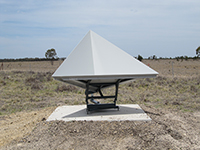News
Network measures Earth movements with increased accuracy
Published:30 June 2015

A radar corner reflector installed near
Cecil Plains, in the Darling Downs
region of south-east Queensland
A new state-of-the-art geodetic network installed in the Surat Basin, Queensland can now measure movement of the Earth's surface more accurately, and as a consequence is helping to build understanding of precious resources within the Earth's crust.
The new regional network, built by Geoscience Australia as part of the AuScope Australian Geophysical Observing System project, comprises a system of geodetic survey marks and co-located radar corner reflectors. The network measures surface deformation patterns of the Earth's crust across the Surat Basin with millimetre-level precision and centimetre-level accuracy, supported by the combination of two measurement techniques: the Interferometric Synthetic Aperture Radar (InSAR) and Global Navigation Satellite System (GNSS).
The combination of the InSAR and GNSS geodetic techniques will significantly improve the spatial resolution of surface deformation estimates in this region, enabling mapping of localised surface deformation of the Earth's crust. By monitoring changes in the Earth's surface scientists can improve their understanding of processes which can deform the Earth's crust over time, including subsidence caused by activities such as groundwater and coal seam gas extraction.
Development of regional-scale crustal deformation models is a vital step towards ensuring the modernisation of the national geodetic datum meets the needs of all users, from the personal use of smart phones and hand-held devices to scientific and industrial applications of precise positioning for transport systems, mining, engineering, construction and land survey activities.
The network in the Surat Basin is part of a wider geodetic infrastructure established through AuScope that is designed to improve the accuracy of positions. The infrastructure also includes the robotic GNSS antenna calibration facility at Geoscience Australia headquarters in Canberra and further development of a national continuously operating GNSS network. The high-precision national GNSS network allows geoscientists to monitor large scale changes to the shape of the surface of the continent.
The Surat Basin geodetic network has been described in detail in a recently published article in the Australian Journal of Earth Science, and a Geoscience Australia report that explains the process undertaken to design the radar corner reflectors, which form the basis of the array network.
Further information
Email:




